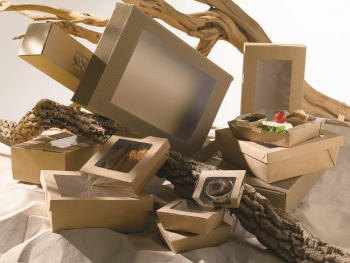Introduce eco-friendly food packaging in the catering industry
The take-away and fast-food sector is growing steadily. According to studies, 2 out of 3 consumers are concerned about the origin of food packaging and its impact on the environment. Moreover, with waste from plastic packaging polluting the oceans, restaurants are willing to go the extra mile and consumers are willing to pay more for committed products!

Eco-friendly packaging and respect for the environment
Eco-packaging has an important place in a sustainable development approach. It must be able to adapt to the needs and constraints of present generations while preserving those of the future. Eco-friendly food packaging has a lower environmental impact but must meet certain criteria to be considered as such:
● It must be healthy and safe for the consumer during its life cycle;
● It must meet current criteria in terms of performance and performance;
● It must use renewable energy sources;
● It must be made from natural materials using clean production techniques;
● It can be recovered.
Have a considerable impact on the protection of the environment
Switching to a whole new range of environmentally friendly food packaging does not happen overnight. There are a few steps to consider to gradually adopt an eco-responsible approach:
● Avoid adding sachets of sauces or condiments in the delivery of your customers' orders. It is better to ask whether they want them or not so as not to waste them.
● Ask your customers if they need cutlery, straws or napkins. Offering these utensils if your customers eat their meals at home is extra wasteful and creates even more waste.
● Remove all extra packaging. Instead of putting the dish in a box and covering it with aluminium foil and then placing it in a bag, ask yourself if a box is not enough or if you have an extra tote bag.
● When ordering dishes online, there is no need to add a paper menu with deliveries.
A wide range of options for food packaging
The use of environmentally friendly food packaging is becoming more and more popular. Fortunately, there are many innovations to minimise waste and to have packaging that is recyclable, compostable and biodegradable. It is important to replace plastic and polystyrene packaging with natural environmentally friendly materials available on the market such as wheat, bamboo, sugar cane pulp, wood pulp and cardboard. Palm leaves are also widely used.
Cardboard and paper: biodegradable packaging that stands out
Paper bags, a major asset in your ecological approach
Ecology has an important place in our daily lives, especially when it comes to food packaging. Whether it's the cup to savour your latte, or the plastic bags available in a bakery, plastic is a significant source of waste. Choosing paper or cardboard packaging for your food products means choosing reusable food packaging. By thinking green, you will be able to stand out from the competition and, above all, you will be able to listen to your customers, who are increasingly concerned about preserving the environment.
Cardboard and paper, for strong packaging
Kraft paper or cardboard are ecological, durable and recyclable materials. Resistant, they offer real security when transporting food. In addition, this zero-waste packaging is intended to guarantee the quality of your products, especially in the fast food sector. If plastic is pointed at because it can transmit particles that are harmful to human health, packaging made from paper and cardboard is 100% natural and harmless. What's more, they can be personalised in many ways.
A wide range of packaging
Cardboard and paper packaging are intended to be modular. They can be transformed to meet your communication objectives. You can therefore choose them in a variety of shapes: cups, pizza boxes, soup or pasta pots, there are many variations.
You are guaranteed to benefit from food packaging that will meet all your needs. What's more, the cardboard and paper are easy to fold and are simple to recycle. With no limit to their uses, they are accessible to all budgets! It's up to you to choose the packaging that meets your communication objectives.
Other environmentally friendly materials for food packaging
While it is true that cardboard is widely used to make different types of packaging, it is not the only material you can use in food packaging.
Corn starch
Many catering professionals are opting for corn starch. It is a biodegradable single-use packaging for take-away sales. It will protect from food contact effectively during the transport of food.
Biodegradable plastic
It is a more ecological alternative to traditional plastic because it can decompose in daylight. It can be used to make bags or trays. Derived from oil, conventional plastic is difficult to degrade and contaminates the entire planet with its waste.
Bagasse or sugar cane pulp
Sugarcane pulp is a fibrous material. When it is crushed, only the bagasse remains. Privileged in fast food restaurants, it is used to make disposable insulating containers!
Reed fibres
The advantage of reed is that it grows quickly. It is compostable and can be used as fertilizer. Recommended for take-away sales, it can be used to wrap a sandwich or to keep your Chips warm.

